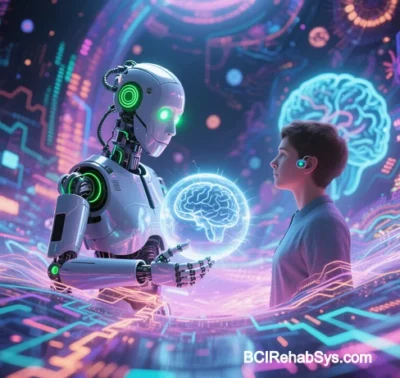
BCIRehabSys: Breakthroughs in Neural Injury Rehabilitation through Brain-Computer Interface Integration
The Brain-Computer Interface Rehabilitation System (BCIRehabSys) redefines neural injury treatment by integrating artificial intelligence (AI), robotics, and neuroscience. Its core innovation lies in establishing a dynamic “brain-machine-physiological feedback” loop, transforming passive rehabilitation into active neural remodeling while advancing precision, personalization, and intelligent care.
I. Core Technological Innovations
- Active Rehabilitation Mechanisms
- Intent-Driven Neural Feedback:
High-density EEG caps capture motor cortex signals (e.g., μ and β rhythms), decoded by hybrid LSTM-CNN networks to interpret patient movement intent. A bidirectional closed-loop adaptive system synchronizes exoskeleton control with tactile and electromyographic (EMG) feedback, promoting functional neural network reorganization. - Virtual Reality Neuroplasticity Engine:
Multimodal rehabilitation scenarios (e.g., virtual object-grasping tasks) activate mirror neuron systems through integrated visual-auditory-tactile stimuli, enhancing motor imagery capabilities.
- Intent-Driven Neural Feedback:
- AI-Driven Precision Therapy
- Adaptive Algorithm Framework:
Federated learning synthesizes multicenter clinical data to optimize stimulation parameters in real time via dynamic threshold models. - Neuroplasticity Prediction:
Graph neural networks (GNNs) analyze DTI-MRI and EEG functional connectivity to forecast neural remodeling potential, guiding personalized treatment plans.
- Adaptive Algorithm Framework:
- Robotics Integration
- Bionic Exoskeletons:
Seven-degree-of-freedom upper-limb robots with flexible actuation and impedance control enable full-cycle training from gross motor skills to fine grasping. - Hybrid Reality Prosthetics:
Implantable cortical electrodes and EMG signals achieve 96% accuracy in gesture recognition for neuro-controlled prosthetics.
- Bionic Exoskeletons:
II. Key Technological Advances
| Domain | Innovation | Clinical Impact |
|---|---|---|
| Signal Decoding | Multimodal fusion (EEG+fNIRS+EMG) | Real-time “mind-to-action” synchronization |
| Device Interface | Nanoscale flexible electrode arrays | Enhanced long-term wearability |
| Rehab Strategy | Hebbian learning reinforcement | Accelerated neural pathway regeneration |
| System Integration | Edge-cloud computing architecture | Remote rehabilitation monitoring |
III. Clinical Applications
- Post-Stroke Motor Recovery
- BCI-FES (functional electrical stimulation) combined with robotic training improves Fugl-Meyer scores significantly, with heightened mirror neuron activation and cortical reorganization.
- Spinal Cord Injury Rehabilitation
- Epidural stimulation (EES) and brain-controlled exoskeletons enable chronic injury patients to achieve functional walking and muscle recovery.
- Breakthrough: Paraplegic patients using motor imagery-controlled exoskeletons sustain standing for extended durations.
- Neuropathic Pain Management
- Theta-pulse stimulation reduces thalamocortical hyper-synchronization, alleviating chronic pain with sustained efficacy.
IV. Scientific Impact
- Neuroplasticity Validation:
fMRI confirms increased connectivity in compensatory neural networks and gray matter density post-BCI training. - Interdisciplinary Synergy:
Combines neural engineering (0.01N force feedback), AI (millisecond-level decoding), and BCI for bidirectional communication.
V. Challenges and Future Directions
- Technical Hurdles:
- Signal noise reduction algorithms to address motion artifacts.
- Enhanced personalization for frontal lobe injury cases.
- Emerging Frontiers:
- Optogenetic-fNIRS systems for neurovascular coupling.
- P300-N400 wave analysis for cognitive rehabilitation.
- Industrial Translation:
- Miniaturized cortical electrodes for clinical trials.
- Metaverse-based VR platforms for collaborative rehab optimization.
Conclusion
BCIRehabSys bridges brain-computer interfaces, AI, and robotics to push the boundaries of neural injury treatment. By actively inducing neuroplasticity, it shifts from functional compensation to potential neural regeneration. Future integration with nanotechnology and quantum computing may unlock unprecedented recovery paradigms.
Data sourced from public references. For collaboration or domain inquiries, contact: chuanchuan810@gmail.com





